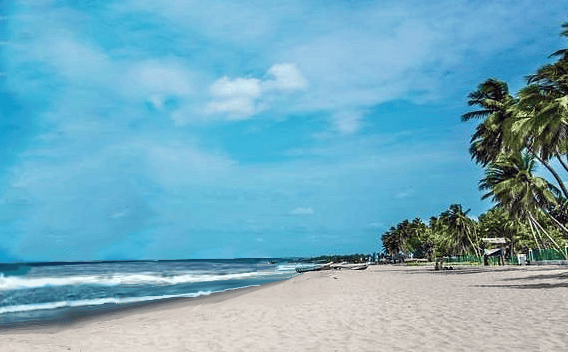Kalpitiya Beach
Kalpitiya Beach, located on the northwest coast of Sri Lanka, is a serene and unspoiled destination known for its pristine beauty, rich biodiversity, and thrilling water sports. This off-the-beaten-path coastal haven is perfect for travelers looking to escape the crowds and immerse themselves in nature. With its golden sands, azure waters, and vibrant marine life, Kalpitiya offers a unique blend of adventure and tranquility.


The Beauty of Kalpitiya Beach
Kalpitiya Beach stretches along a peninsula surrounded by the Indian Ocean on one side and the Kalpitiya Lagoon on the other. This picturesque setting features soft sandy shores, swaying palm trees, and calm waters that create an idyllic environment for relaxation. The area’s pristine, less-developed nature makes it a favorite for eco-tourists and those seeking a peaceful retreat.
A Haven for Water Sports and Activities
Kalpitiya Beach is renowned for its wide range of water-based activities, catering to adventure enthusiasts and nature lovers alike:
Kite Surfing: Kalpitiya is one of the best kite surfing destinations in Asia, thanks to its consistent winds from May to October. Both beginners and experienced kite surfers flock to the area to enjoy the thrilling conditions.
Dolphin and Whale Watching: The waters off Kalpitiya are home to pods of spinner dolphins, making it one of the best spots in Sri Lanka for dolphin-watching tours. From November to April, visitors can also spot blue whales and sperm whales during organized excursions.
Snorkeling and Diving: The nearby Bar Reef, one of Sri Lanka’s largest coral reefs, offers incredible snorkeling and diving opportunities. The reef’s vibrant marine life includes tropical fish, sea turtles, and colorful coral formations.
Kayaking and Paddleboarding: Explore the tranquil waters of Kalpitiya Lagoon with a kayak or paddleboard, offering a closer look at the area’s lush mangroves and diverse wildlife.
Wildlife and Nature
Kalpitiya’s unique location makes it a biodiversity hotspot. The lagoon and surrounding mangroves are home to a variety of bird species, including flamingos, herons, and kingfishers. Nature enthusiasts can also explore Wilpattu National Park, located nearby, which is known for its leopards, elephants, and other wildlife.
Cultural and Historical Attractions
While Kalpitiya is best known for its natural beauty, it also boasts cultural and historical significance. Visitors can explore the remnants of the Kalpitiya Dutch Fort, a colonial-era structure that offers a glimpse into Sri Lanka’s history. The local fishing communities also provide insight into traditional ways of life, with opportunities to learn about their customs and practices.
Best Time to Visit
The best time to visit Kalpitiya Beach depends on your interests:
Kite Surfing: May to October is ideal for kite surfing, with strong and steady winds.
Dolphin and Whale Watching: November to April offers the best conditions for spotting marine life.
Relaxation: The beach’s tranquil atmosphere can be enjoyed year-round, although the dry season (November to April) provides the most pleasant weather.
Where to Stay and Eat
Kalpitiya offers a range of accommodations, from eco-friendly lodges and boutique resorts to budget guesthouses. Many properties emphasize sustainability and blend harmoniously with the natural surroundings.
Dining options include beachfront restaurants and local eateries serving fresh seafood, Sri Lankan curries, and international dishes. Don’t miss the chance to try local delicacies like crab curry and lagoon prawns.
Tips for Travelers
Respect Nature: Kalpitiya’s ecosystem is fragile, so visitors are encouraged to minimize their impact by avoiding plastic waste and supporting eco-friendly activities.
Bring Essentials: The area is relatively remote, so bring sunscreen, insect repellent, and other necessities.
Plan Ahead: Activities like dolphin-watching tours and kite surfing lessons are best booked in advance, especially during peak seasons.



